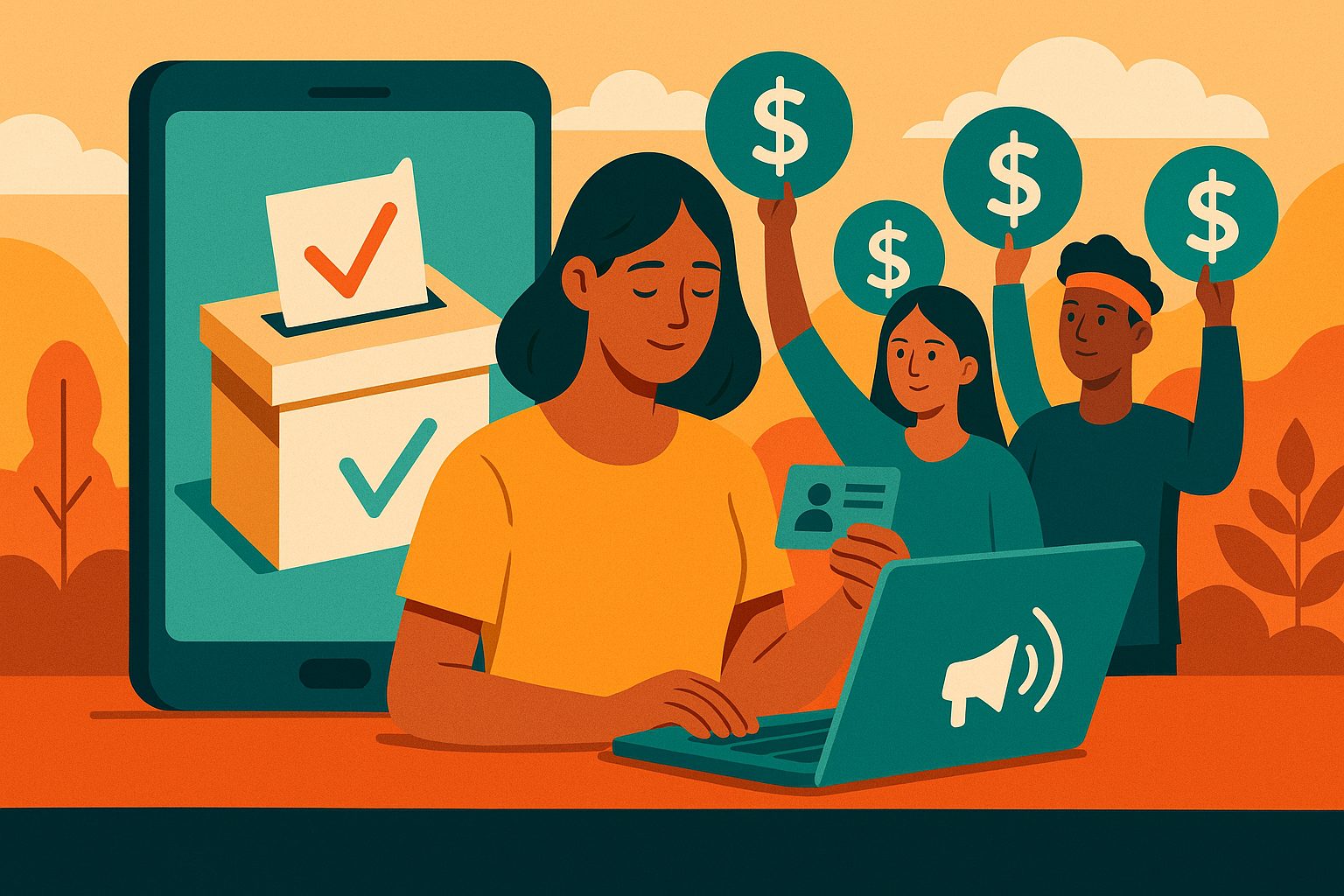Empowering Democracy Through Collective Action
Voter registration is the cornerstone of democratic participation. It’s the first step in ensuring that citizens have a voice, a ballot, and a role in shaping the future of their communities. But organizing a voter registration drive isn’t easy—it takes time, dedication, and resources. That’s where crowdfunding comes in. Crowdfunding has become a powerful tool for organizers, activists, and community leaders looking to fund civic engagement efforts without relying on traditional grants or institutional backing. It turns everyday supporters into partners in progress. With a compelling story and a smart digital strategy, you can raise the funds needed to print materials, train volunteers, rent venues, and boost outreach. This guide takes you step by step through the process of using crowdfunding to support your voter registration efforts, from setting your mission to celebrating your success. It’s not just about fundraising—it’s about fueling democracy from the ground up.
Clarifying Your Mission and Setting Your Goals
Before launching your crowdfunding campaign, you need clarity. What exactly are you raising money for? How many voters do you plan to register? Where will the drive take place? The more specific you are, the more confident donors will feel in supporting your cause. Is your focus on reaching underserved communities? Are you targeting a youth demographic or first-time voters? Spell out your mission clearly and make your objectives measurable. Donors want to know what impact their contributions will make. Are you trying to raise $5,000 to register 2,000 new voters across rural districts? Are you organizing a mobile registration tour with bilingual volunteers? Clarity builds trust and inspires confidence. Your campaign should explain not only what you’ll do with the money, but why it matters—especially in today’s politically charged landscape, where voting rights are a flashpoint for equity, access, and change.
Selecting a Crowdfunding Platform That Supports Your Vision
Not every crowdfunding platform is built for civic engagement. When choosing a platform, you want one that aligns with your values and makes it easy for donors to contribute. Platforms like GoFundMe and Fundly are popular for community campaigns and voter initiatives. If you’re working with a nonprofit or fiscal sponsor, sites like Givebutter or Donorbox may offer better integration for recurring donations and donor management. It’s also important to consider user experience. Does the platform make it easy to share your campaign on social media? Does it offer mobile optimization, thank-you emails, and analytics dashboards? These features can make a big difference in tracking progress and engaging your base. Choose a platform that will serve you not just on launch day, but throughout your entire campaign. The right digital infrastructure sets the stage for consistent growth and community engagement.
Building Your Campaign Page with Purpose
Your campaign page is more than just a place to collect donations—it’s the heart of your message. Think of it as a digital rally cry, where people come to be informed, inspired, and moved to act. Your headline should be bold, your summary should be clear, and your visuals should be powerful. Include photos or videos from past events if you’ve organized them, or create new content that highlights the need for voter registration in your target area. Use personal stories, statistics, and community voices to show what’s at stake. Explain the cost breakdown—where exactly will the money go? Are you paying for volunteers’ training, transportation, printing flyers, or digital ads? This transparency helps build credibility and encourages larger gifts. When supporters land on your page, they should feel your energy, your vision, and your commitment to building a better democracy.
Prepping for a Strong Campaign Launch
Launching your campaign is about building anticipation and hitting the ground running. A strong launch can set the tone for your entire fundraising timeline. Before you go public, reach out to your closest network—friends, family, community allies—and ask them to contribute the moment the campaign goes live. These early donations create momentum and show potential backers that you already have support. Use teasers on your social channels, email blasts, and even offline conversations to build buzz. The first 24 to 72 hours are critical for catching the attention of algorithms, social feeds, and potential press. Launch with a personal video message if possible—it creates connection and shows authenticity. Make it easy for people to donate, share, and stay involved. When launch day comes, be active, be visible, and be ready to ride the wave of initial interest.
Creating Content That Captures Attention
Your crowdfunding campaign doesn’t end once it’s live—it’s just beginning. Sustaining engagement means producing content that resonates and motivates. Share stories of people in your community who face voting barriers. Post updates on milestones reached and progress made. Show behind-the-scenes photos of volunteer training, event setup, or planning meetings. Go live on Instagram or Facebook to answer questions and talk about why this work is urgent. Use reels, tweets, and TikToks to reach different audiences, always tailoring your message to the platform’s vibe and voice. Be consistent with your posting schedule and tone. Make your content emotional but solution-driven. People donate when they feel both the problem and the possibility. Keep asking—politely, powerfully, and personally. The more content you create, the more opportunities you have to convert passive followers into active donors.
Engaging Donors and Building Community
Donors are not just wallets—they’re potential volunteers, advocates, and community partners. Treat them that way. Thank them quickly and publicly. Use your campaign updates to highlight donor stories, shout out returning contributors, and create a sense of shared ownership. Ask your donors to repost your campaign, bring in new supporters, or participate in digital events. Turn your donor base into a team. Engagement builds community, and community is the bedrock of every successful advocacy campaign. Make your campaign feel like a movement, not just a fundraiser. Host virtual town halls, digital workshops, or even community meet-ups. When people feel like they’re part of something larger than themselves, they don’t just give—they invest emotionally. And emotional investment is the foundation of long-term impact and sustainability.
Using Matching Gifts and Challenges to Build Momentum
One powerful way to keep the excitement going is to use matching donations or fundraising challenges. Ask a local business, union, or community leader to pledge a matching gift if your campaign hits a certain milestone. Promote the match widely and update your audience in real-time as you close in on your target. You can also run themed fundraising days—such as “$10 Tuesday” or “Weekend for the Vote”—to generate short bursts of activity. These tactics add urgency and fun to your campaign. They also give your followers fresh reasons to share your message. The more interactive and time-sensitive your asks, the more likely they are to catch fire. Keep momentum alive by varying your strategy, celebrating small wins, and always returning to your core message: every dollar brings more people to the polls.
Measuring Success Beyond Dollars Raised
Fundraising is essential, but it’s not the only metric that matters. Crowdfunding a voter registration drive should also be measured by engagement, reach, and long-term capacity building. Track how many new followers you gain, how many shares your campaign gets, and how many people sign up to volunteer or attend events. Use these insights to adapt your strategy. If video content performs better than static posts, create more videos. If people respond well to personal stories, collect and share more testimonials. Let the data guide your decisions without losing the heart of your message. Also, take stock of what you’ve learned. Did you build new relationships? Did your team gain new skills? Did your campaign spark conversation about voter access in your community? These outcomes are just as important as your final donation count, because they lay the groundwork for future campaigns and ongoing impact.
Wrapping Up and Reporting Back
When your campaign ends, your work isn’t over—it’s just evolving. Post a big thank-you to everyone who supported you, and give them a report on how the funds will be used. Transparency here is critical. Break down the results: how many people registered to vote, how many events you held, what challenges you faced, and what’s next for your organization or initiative. This level of honesty builds long-term trust and turns one-time donors into lifelong supporters. Send out follow-up emails, update your campaign page, and keep your social feeds active with post-campaign reflections. Let people know they made a difference. Whether your drive reached 500 voters or 5,000, your efforts mattered—and the people who helped make it happen should feel that.
Sustaining the Movement Beyond the Campaign
Crowdfunding a voter registration drive is not just a fundraising activity—it’s a stepping stone toward sustained civic power. Use the energy you’ve built to plan your next initiative, whether it’s GOTV (get out the vote) canvassing, ballot education, or policy advocacy. Keep your supporters engaged with monthly updates, behind-the-scenes videos, or stories from voters who participated in your drive. Consider building a newsletter or community forum to keep the dialogue going. If you registered young voters, consider how to keep them politically engaged long after their first ballot. If you reached marginalized communities, ask them what they need next. Crowdfunding is just the beginning. When combined with authentic engagement, consistent communication, and a commitment to justice, it becomes a platform for real change. You didn’t just raise money—you raised awareness, built relationships, and made democracy more accessible for those who need it most.




